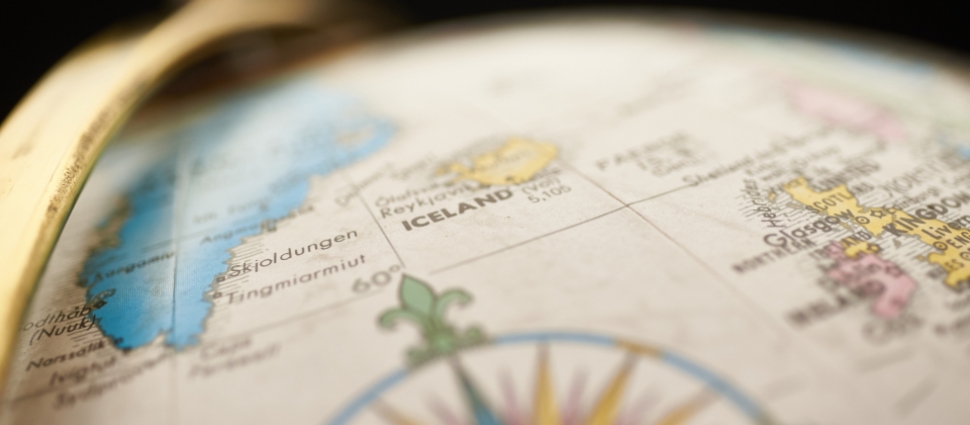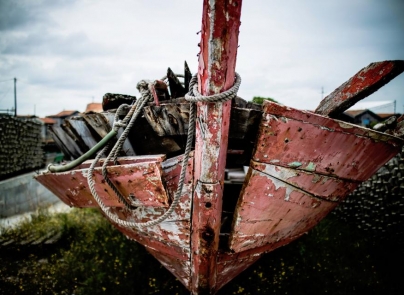Hallgrímur Pétursson – Iceland’s Poet of Comfort

Hallgrímur Pétursson – Iceland’s Poet of Comfort
The news that Hallgrímur Pétursson was ordained as Lutheran minister at Hvalsnes, Iceland, raised many eyebrows. He had not completed his education and, what was worse, he had fathered a child out of wedlock. But Brynjólfur Sveinsson, bishop of Skálholt, believed that Pétursson had repented and was ready for the ministry. Time proved him right.
Overturned Plans
Pétursson was likely born in 1614 at Gröf of Skagafjörður, in the northern region of Iceland. While he was still young, his family moved south to Hólar, where his cousin Guðbrandur Þorláksson was a bishop over the local Lutheran churches. Pétursson’s father served as a bell-ringer.
As a young man, Pétursson left home and travelled to mainland Europe, possibly to learn the blacksmith trade. He met Sveinsson in Copenhagen, Denmark. Sveisson, who had recently graduated from the University of Copenhagen, was already esteemed as a poet and churchman. He encouraged Pétursson to attend the seminary at the Vor Frue Skole in the same city, and probably sponsored his studies.
Pétursson was in his last year of seminary, with good prospects for his future, when an event turned his life upside down.
Around 1637, a group of about 27 Icelanders landed in Copenhagen. They were part of a group of 300 people who had been kidnapped ten years earlier by North African pirates and had been sold as slaves in Algiers. This raid, known as the Turkish Abductions, had inflicted a heavy toll to an economically poor and scarcely populated country.[1]
At that time, Algiers was a powerful city in the Ottoman Empire, where slaves were in high demand. Since ancient times, slaves from northern Europe had been especially prized for their size and strength.
Pètursson was sent to minister to this group of ransomed slaves. One of them, Guðríður, had arrived without her son, who had been kidnapped with her when he was four and was never released. This was a common story. The ransomed Lutheran pastor Ólafur Egilsson, who had been abducted at the same time, was able to rescue his wife, but never saw his children again.[2] That’s because children of captives were forced to convert to Islam and, by doing so, lost all rights of moving back to a Christian country.
Guðríður and Hallgrímur fell in love, in spite of their age difference (she was sixteen years his senior). Eventually, their relationship resulted in a pregnancy. To make things worse, Guðríður was a married woman, whose husband had escaped the raid. Unable to continue his studies, Hallgrímur moved back to Iceland with Guðríður and settled in Njarðvík, a village in the Reykjanes Peninsula. The two lived in separate homes.
With the help of friends, Pètursson found work for Hallgrímur and was able to avoid the punishment (either a hefty fine or a flogging) the government imposed on adulterers. Hallgrímur did some manual labor, then worked as an interpreter for Danish merchants.
In the meantime, Guðríður looked for her husband, Eyjólfur Sölmundsson. She had written a letter to him in 1635 but had never received a reply. She discovered that he had remarried, fathered more children, and died in a shipwreck. Sölmundsson’s death gave Hallgrímur and Guðríður legal rights to marry. This allowed them some respectability, although some legends rose about Guðríður being a witch who enchanted Hallgrímur[3].
Pastor and Poet
After his unlikely ordination, Pétursson pastored the church in Hvalsnes, near Sandgerði (in the same peninsula where he had been living). He was not unanimously well received. Some resented the fact that he had been ordained in spite of his insufficient education and his stained past. A story is told of a man who poked a hole in the communion chalice just to get Pétursson in trouble.
But the greatest sorrow of Pétursson’s life was the death of his three-year daughter Steinunn. He wrote two funeral elegies for her. One is still sung at Icelandic funerals today. The poem starts with the biblical comparison of human life to a flower that flourishes briefly, and is gone, reflecting on the uncertainty of life, and on man’s inability to stop death.
Since Adam's nature courses
Through every human vein,
My heritage enforces
Return to dust again.
Life is no freehold, granted
To seisin or the sword;
My soul, in flesh implanted,
Was lent me by the Lord;
In his control it standeth
To claim his own anew;
Death is the slave he sendeth
To seek the Maker's due
But, in the face of this reality, there is another, equally undeniable truth.
For sure in love abideth
My Saviour on his throne
O’er all things he presided
Jesus his nature alone.
Death’s victor, condescending
Upon the cross he died
And thus did life unending
For me, poor wretch, provide.
Death, from its power defeated,
Was overthrown and slain;
From sovereign powers unseated
To harm me ne’er again.
Though earth my flesh may cover,
My ransomed soul shall rise,
Its toils and torments over
To bliss above the skies.[4]
In the course of six years, Pétursson proved himself a good pastor, and was promoted to the more comfortable parish of Saurbær in Hvalfjarðarströnd, about 50 miles north of Sandgerði. The time from 1650 to 1660 was the best of his life, and he was able to write many new poems, including the collection known as the Passion Hymns.
These fifty songs were meant to be sung, one for each working day, during Lent, as a way to trace Jesus’s steps from the Garden of Gethsemane to the tomb. They spoke directly to the hearts of Icelanders, who lived a difficult life, and explained how each aspect of Christ’s life and death was for their benefit,
Pétursson’s experience with the frailty of human nature caused him to cling tightly to the only One who can forgive, redeem, and strengthen against those frailties. His response to Christ’s forgiveness of Peter is one example:
Whene'er in act or word,
Slighting Thy warning grace,
Like Peter, I deny Thee, Lord,
Toward me turn Thy face.
Yea, Master, turn and look
On me in love untold:
Cast that same searching glance, which broke
The Apostle’s heart of old;
Until with weeping eyes
I gaze toward Thy heaven:
Then, Saviour, speak the word, “Arise!
Arise, restored, forgiven!”[5]
Many people memorized these hymns, which are still used both in church and in family devotions (a strong tradition in a country where much of daily life is spent at home).
The series, unique in Icelandic literature, was completed in 1659 and published in 1666. Today, it is considered one of the finest examples of Icelandic poetry, and has been at elast partially translated into many languages, including Danish, Norwegian, English, German, Dutch, Hungarian, Italian, and Chinese.
Pétursson wrote many other works, both in poetry and in prose. For example, in the Diarium Christianum, he included one meditation for each day of the week, based on each of the days of creation, adding practical applications and ending with a prayer. About the creation of birds, he says, “My Lord Jesus, make my heart fly up from earthly vanity to you in heaven … Do not let me become a disgusting carrion bird in your sight, nor have the bird of prey’s nature or the raven’s disposition towards my neighbour.”[6]
He also reflects on the beauty of birds and the rest of creation (recalling Matthew 6:26-29) and reminds his readers to live in constant praise of the Creator. “Man should never set foot on the earth, and never wash in cool water or slake his thirst there, and never view the grasses or the verdant wood without offering due thanks to the gracious giver and omnipotent creator for all this.”[7]
A new calamity struck in 1662, when every building in town, except the church, went up in flames. Pétursson’s farm was also burned. Thankfully, every citizen survived, and most of the clothing and food were saved.
Pétursson experienced a new challenge in 1665, when he was struck with leprosy. He was still able to preach and attend some meetings, but eventually had to retire and spent his last years bedridden and almost blind. His most moving hymns were written during this time. He died at Ferstikla, near Saurbær, on 27 October 1674.
In his vision of life and death as tokens of God’s will, and of each human being as a participant in God’s redemptive history, Pétursson had prepared for death for all his life, and had trained his parishioners to do the same.
None, none can aid but Thou, Almighty Lord;
I stay me on Thine everlasting Word;
Let earth decay, heaven's far-flung glories pale,
Jehovah's plighted word can never fail.
Within the Eternal Arms I sink to rest,
Washed in the stream that flowed from Jesus' breast:
The life Thou gavest, Father, now defend;
Into Thine Hands my spirit I commend.
Let the last psalm my dying voice can raise,
Extol Thy loving-kindness, hymn Thy praise:
Let the first notes my wakening lips can frame
Amid the eternal glory, laud Thy Name.
First, midst, and last, through that unclouded day,
I would my Saviour's boundless grace display,
And swell the anthems of the ransomed host,
Adoring Father, Son, and Holy Ghost.[8]
Guðríður stayed with their son Eyjólfur at Ferstikla. After Eyjólfur’s death in 1679, she lived with séra Hannes at Saurbær, where she died in 1682, aged eighty-four.
[1] Some of the details of the raid are described in the 2003 movie “Atlantic Jihad,” https://www.youtube.com/watch?v=txoKdfiWJV0
[2] See Ólafur Egilsson, The Travels of Reverend Ólafur Egilsson: The Story of the Barbary Corsair Raid on Iceland in 1627, transl. by Adam Nichols and Karl Smari Hreinsson, The Catholic University of America Press, 2016. A famous victim of pirate raids in the sixteenth century was Miguel de Cervantes, author of Don Quixote, who lived as a prisoner in Algeria for some time. The Italian Reformer Giulia Gonzaga barely escaped one of these raids.
[3] A well-researched historical novel by Steinunn Johannesdottir about this couple, Reisubók Guðríður Símonardóttir (“The Travels of Guðríður Símonardóttir”), released in Icelandic in 2002, has become a national best seller and has been translated in many languages. It was never translated in English because, after 9/11, American publishers refused to publish a book about the Turkish raids of the 1600’s.
[4] Hallgrímur Pétursson, “On Death’s Uncertain Hour,” transl. by G. M. Gatherone-Hardy, in Kirkjuritid, April 1964, 162, https://timarit.is/page/4742088#page/n0/mode/2up
[5] Hallgrímur Pétursson, “The Lord Turned and Looked Upon Peter,” in Passion Hymns of Iceland, translated and edited by C.V. Pilcher, https://ccel.org/ccel/pilcher/passionhymns/passionhymns.h1.h05.html
[6] Daisy Neijmann, A History of Icelandic Literature, University of Nebraska Press, 2006, 204
[7] Margrét Eggertsdóttir, Islandica 56: Icelandic Baroque: Poetic Art and Erudition in the Works of Hallgrímur Pétursson, Cornell University Library, 2014, 452, https://ecommons.cornell.edu/bitstream/handle/1813/55844/ISL_1415637606_...
[8] Hallgrímur Pétursson, “Hallgrímur Pétursson’s Death Bed Hymn,” in Passion Hymns of Iceland, https://ccel.org/ccel/pilcher/passionhymns/passionhymns.h1.h14.html





